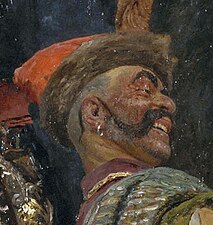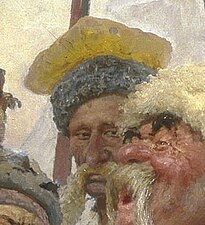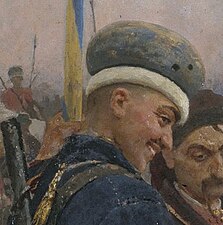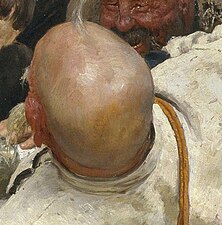Reply of the Zaporozhian Cossacks
| Reply of the Zaporozhian Cossacks | |
|---|---|
 | |
| Artist | Ilya Repin |
| Year | 1880–1891 |
| Medium | Oil on canvas |
| Dimensions | 203 cm × 358 cm (80 in × 141 in) |
| Location | State Russian Museum, Saint Petersburg |
Reply of the Zaporozhian Cossacks is a painting by Ilya Repin.[1] It is also known as Cossacks of Saporog Are Drafting a Manifesto and Cossacks are Writing a Letter to the Turkish Sultan[a].
Repin began painting the canvas in 1880 and finished in 1891. His study drawings he made in stanitsa Pashkovskaya (today within Krasnodar), Yekaterinoslav (today Dnipro), and Kachanivka.
He recorded the years of work along the lower edge of the canvas. Alexander III bought the painting for 35,000 rubles. Since then, the canvas has been exhibited in the State Russian Museum in Saint Petersburg with another version by Repin in the Kharkiv Art Museum in Kharkiv, Ukraine.[2]
Context[edit]
Historicity[edit]
Reply of the Zaporozhian Cossacks depicts a supposedly historical tableau, set in 1676, and based on the legend of Cossacks sending an insulting reply to an ultimatum from the Sultan of the Ottoman Empire, Mehmed IV.[citation needed]
According to the story, the Zaporozhian Cossacks (from "beyond the rapids", Ukrainian: za porohamy), inhabiting the lands around the lower Dnieper River in Ukraine, had defeated Ottoman Empire forces in battle. However, despite his army having suffered this loss to them, Mehmed demanded that the Cossacks submit to Ottoman rule. The Cossacks, led by Ivan Sirko, replied in a characteristic manner: they wrote a letter, replete with insults and profanities. The painting exhibits the Cossacks' pleasure at striving to come up with ever more base vulgarities.[3]
In the 19th century, the historical Zaporozhian Cossacks were sometimes the subject of picaresque tales demonstrating admiration of their primitive vitality and contemptuous disregard for authority (in marked contrast to the more civilized subjects of the authoritarian Russian state).[4] Whether the incident portrayed actually happened or is just another of these tales is not known, but no concrete or reliable evidence exists that it did happen,[4] although the question remains disputed.[5]
U.S.-based Slavic and Eastern European historian Daniel C. Waugh (1978) observed: "The correspondence of the sultan with the Chyhyryn Cossacks had undergone a textual transformation sometime in the eighteenth century whereby the Chyhyryntsy became the Zaporozhians and the controlled satire of the reply was debased into vulgarity. In this vulgar version, the Cossack correspondence spread quite widely in the nineteenth century. (...) The best-known reflection of the nineteenth-century popularity of the Cossack correspondence is the famous painting by II'ia Repin showing the uproarious Zaporozhians penning their reply."[6]
Repin's interpretation[edit]
Nikolai Gogol's 1842 romantic-historical novella Taras Bulba describes the incident in passing. Repin associated with Savva Mamontov and his artistic circle and probably heard the story there; at any rate, Repin made his first sketches for the painting in Mamontov's home.[4]
.jpg/220px-Reply_of_the_Zaporozhian_Cossacks_(sketch%2C_1893%2C_Kharkiv).jpg)
While working on the original version, Repin in 1889 began work on a second version. This work remained unfinished. The artist tried to make the second version of The Cossacks more "historically authentic". In 1932 it was transferred by the Tretyakov Gallery to the M. F. Sumtsov Kharkiv Historical Museum. In 1935, it was moved to the Kharkiv Art Museum, where it is now stored. This canvas is slightly smaller than the original version.
The historian Dmytro Yavornytsky assisted Repin in portraying the scene authentically.[5]
During the Russian invasion of eastern Ukraine in March 2022, when the Kharkiv region came under heavy artillery and air fire, the museum staff rushed to remove their artworks from the museum to a safer place. The second version of The Cossacks was amongst the artworks relocated for safety.[2]
Models[edit]
The "Cossacks” who posed for the painting were friends of Repin and academics from Saint Petersburg University, and included men of Ukrainian, Russian, Cossack, Jewish and Polish ancestry.[7][8]
-
Taras Bulba, leader of the Cossacks
-
"The Writer"
-
"The smiling soldier" (Otaman Ivan Sirko)
-
"Smiling soldier with red cap"
-
"Cossack with yellow hat"
-
"Tall smiling man"
-
"Serious cossack"
-
"Top of a bald head"
Character
|
Notes
|
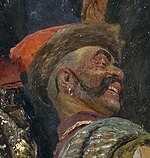 |
The "Smiling soldier with a red cap" was modelled by Jan Ciągliński, a teacher of drawing in Petersburg and an active participant in the World of Art movement. He was of Polish ancestry. |
 |
The "Tall smiling man", who portrays Andriy, the younger son of Taras Bulba, is the son of the Russian aristocrat Varvara Uexküll von Gyllenband, and the great-nephew of the composer Mikhail Glinka. |
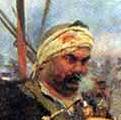 |
A tall cossack with a headband on his head is Odesa painter Nikolai Kuznetsov, an ethnic Greek. He was a joker, a strongman, an academician of the Academy of Arts, professor, a class director of battle painting in the Academy. |
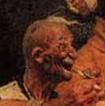 |
Toothless and wrinkled old man with a tobacco pipe was captured by Repin from a casual trip companion at a pier of the city of Alexandrovsk (today Zaporizhia). |
 |
Typical bursa student with his hair cut "Makitra" way and who was not able yet to grow a mustache is Porfyriy Martynovych. He studied at the Academy of Arts, skilled in filigree graphics, but due to his illness at his 25 he was forced to leave landscape painting. Repin never saw him live therefore his character he drew not from live Martynovych, but a gypsum mask taken from a face of the young painter. When they took of the mask from him, he smiled and the smile was left with the mask. So, it was captured by Repin. |
 |
The "Serious Cossack" was modelled by the art patron Vasyl Tarnovsky, an important supporter of Ukrainian culture. |
 |
Image of Cossack-Holota ("impoverished") was modeled from a coachman of Vasyl Tarnovsky Mykytka. Repin, while being impressed by the way Mykytka was edentulous, cyclopic, drunk and ridiculous, was able to capture him when he with Tarnovsky were crossing Dnieper on ferry. |
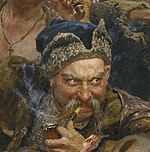 |
"The Smiling Soldier", in the role of Otaman Ivan Sirko, was modeled by General Mikhail Dragomirov of the Russian army and Governor-General of Southwestern Krai. |
 |
The character that depicts a Tatar was drawn from an actual Tatar student. |
 |
"Taras Bulba", the leader of the Cossacks, was modelled by Alexander Ivanovich Rubets, professor at Petersburg University |
 |
The "Cossack with a yellow hat", almost hidden by Taras Bulba, was modelled by Fyodor Stravinsky, an opera singer with the Mariinsky Theatre, of Polish descent, and the father of the composer Igor Stravinsky. |
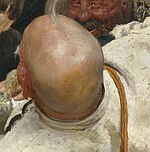 |
The "Top of a bald head" belongs to Georgi Alekseyev, who was Grand Chamberlain of the court of the Russian Emperor, in charge of court finances. He was invited to pose for the role, but refused, as he felt it was undignified. Instead, Repin sketched the back of his head while Alekseyev was engaged in looking at an exhibit of prints. When he saw the painting, Alekseyev recognized his head, and was not pleased, but by then the painting was in the imperial collection.[7][8] |
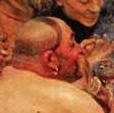 |
Half-naked Zaporizhia warrior is a friend of Repin and Yavornytsky and a teacher at folk school Kostiantyn Belonovsky. As a card player he was on the painting, not in real life. |
 |
"The writer" was modelled by the historian and archeologist Dmytro Yavornytsky, the author of a major work on the history of Zapporzhian Cossacks |
Depictions[edit]
The image has become a well-known reference in Russian culture, parodied or emulated by other work such as political cartoons, including Members of Duma drafting a reply to Stolypin[9] and Soviet leaders write the letter of defiance to George Curzon,[10] seen below. It is also referenced in other works, such as both the 2009 Russian film Taras Bulba, which depicts the scene itself, and the American film of the same name (which includes the painting in its opening credits); both are adaptations of a historical novella by that name, though the novella does not include the scene.


Beyond Russia, the painting is frequently used as a symbol or metonymy for Cossacks in general. The "Cossacks" expansion to the video game Europa Universalis IV adapted the text of the reply for its trailer and included artwork based on the original painting,[11] the game Cossacks: European Wars has the central detail of the picture in its logo, and the game Cossacks 3 has the painting as the background of the main menu.
The text has inspired several adaptations; most notable is probably the French versification by Guillaume Apollinaire, included as "Réponse des Cosaques Zaporogues au Sultan de Constantinople" as part of his poem "La Chanson du mal-aimé", in his 1913 collection Alcools. This version was set to music by Dmitri Shostakovich in his Symphony No. 14, amongst other poets, and by French singer-songwriter Léo Ferré, in a full oratorio on La Chanson du mal-aimé in 1953.
Not all treatment of the painting has been positive. Particularly, art critic Clement Greenberg's influential 1939 essay Avant-Garde and Kitsch selected Repin's painting as an example of "kitsch".[12]
Notes[edit]
References[edit]
- ^ "Ilya Yefimovich Repin | Biography, Art, & Facts". Encyclopedia Britannica. Retrieved 31 December 2020.
- ^ a b Solomon, Tessa (11 May 2022). "A Continually Updated List of Ukraine's Most Significant Cultural Sites Damaged Amid Russia's Invasion". ARTnews.com. Retrieved 8 June 2022.
- ^ Ilya Repin – Peindre, Claude Pommereau (editor), Beaux Arts Editions, Paris, October 2021, p. 15 (in French)
- ^ a b c Walther K. Lang (Spring 2002). "The Legendary Cossacks: Anarchy and Nationalism in the Conceptions of Ilya Repin and Nikolai Gogol". Nineteenth-Century Art Worldwide. Retrieved 10 March 2021.
- ^ a b "InfoUkes: Ukrainian History – The Cossack Letter: "The Most Defiant Letter!"". www.infoukes.com. Retrieved 16 March 2020.
- ^ Waugh, Daniel. C. (1978). The Great Turkes Defiance: On the History of the Apocryphal Correspondence of Ottoman Sultan in its Muscovite and Russian Variants. Columbus, Ohio. p. 169. ISBN 978-0089357561.
{{cite book}}: CS1 maint: location missing publisher (link) - ^ a b История создания картины «Запорожцы пишут письмо турецкому султану»
- ^ a b "Запорожцы пишут письмо турецкому султану – bubelo.in.ua".
- ^ Special:FilePath/Members of Duma are drafting a reply to Stolypin.jpeg
- ^ Special:FilePath/Soviet leaders write the letter of defiance to George Curzon.jpg
- ^ "Europa Universalis IV – The Cossacks". Paradox Interactive. 15 October 2015. Archived from the original on 22 December 2021.
- ^ Greenberg, Clement (1939). "Avant-Garde and Kitsch". Partisan Review. Retrieved 15 November 2015.
Book references[edit]
- Dmytro I. Yavornytsky (1895) History of the Zaporogian Cossacks, Vol. 2, pp. 517–518. St. Petersburg. Available in both modern Ukrainian and Russian language editions.
- Myron B. Kuropas (1961) The Saga of Ukraine: An Outline History. MUN Enterprises
- Саєнко В.М. (2004) "Лист до турецького султана" та деякі міфологічні відповідності // Нові дослідження пам’яток козацької доби в Україні. – Вип.13. – К. – С. 418–420.
- Prymak, Thomas M., "Message to Mehmed: Repin Creates his Zaporozhian Cossacks," in his Ukraine, the Middle East, and the West (Montreal and Kingston: McGill-Queen's University Press, 2021), pp. 173–200.
- Jack Carr, (2019) True Believer, Atria/Emily Bestler Books, chapter 67.
External links[edit]
- The Cossack Letter
- Friedman, Victor A. (1978), "The Zaporozhian Letter to the Turkish Sultan: Historical Commentary and Linguistic Analysis" (PDF), Slavica Hierosolymitana, Magnes Press, 2: 25–38, retrieved 15 November 2011. A detailed analysis of the letter and its different variants.
- History of the painting (in Russian)
- Reply of the Zaporozhian Cossacks. Outstanding Paintings. St. Peterburg, 1966. p. 271 (in Russian)
- Versified version of the letter sung by singer-songwriter Léo Ferré and choir (1972)




